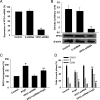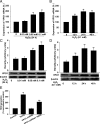Involvement of vascular peroxidase 1 in angiotensin II-induced vascular smooth muscle cell proliferation
- PMID: 21292788
- PMCID: PMC3112017
- DOI: 10.1093/cvr/cvr042
Involvement of vascular peroxidase 1 in angiotensin II-induced vascular smooth muscle cell proliferation
Abstract
Aims: Vascular peroxidase 1 (VPO1) is a newly identified haem-containing peroxidase that catalyses the oxidation of a variety of substrates by hydrogen peroxide (H(2)O(2)). Considering the well-defined effects of H(2)O(2) on the vascular remodelling during hypertension, and that VPO1 can utilize H(2)O(2) generated from co-expressed NADPH oxidases to catalyse peroxidative reactions, the aims of this study were to determine the potential role of VPO1 in vascular remodelling during hypertension.
Methods and results: The vascular morphology and the expression of VPO1 in arterial tissues of spontaneously hypertensive rats and Wistar-Kyoto rats were assessed. The VPO1 expression was significantly increased concomitantly with definite vascular remodelling assessed by evaluating the media thickness, lumen diameter, media thickness-to-lumen diameter ratio and mean nuclear area in artery media in spontaneously hypertensive rats. In addition, in cultured rat aortic smooth muscle cells we found that the angiotensin II-mediated cell proliferation was inhibited by knockdown of VPO1 using small hairpin RNA. Moreover, the NADPH oxidase inhibitor, apocynin, and the hydrogen peroxide scavenger, catalase, but not the ERK1/2 inhibitor, PD98059, attenuated angiotensin II-mediated up-regulation of VPO1 and generation of hypochlorous acid.
Conclusion: VPO1 is a novel regulator of vascular smooth muscle cell proliferation via NADPH oxidase-H(2)O(2)-VPO1-hypochlorous acid-ERK1/2 pathways, which may contribute to vascular remodelling in hypertension.
Figures






Comment in
-
Vascular peroxidase 1/peroxidasin: a complex protein with a simple function?Cardiovasc Res. 2011 Jul 1;91(1):1-2. doi: 10.1093/cvr/cvr120. Epub 2011 Apr 20. Cardiovasc Res. 2011. PMID: 21508041 No abstract available.
Similar articles
-
Involvement of vascular peroxidase 1 in angiotensin II-induced hypertrophy of H9c2 cells.J Am Soc Hypertens. 2017 Aug;11(8):519-529.e1. doi: 10.1016/j.jash.2016.08.002. Epub 2016 Aug 24. J Am Soc Hypertens. 2017. PMID: 27651140
-
The role of vascular peroxidase 1 in ox-LDL-induced vascular smooth muscle cell calcification.Atherosclerosis. 2015 Dec;243(2):357-63. doi: 10.1016/j.atherosclerosis.2015.08.047. Epub 2015 Sep 3. Atherosclerosis. 2015. PMID: 26520887
-
Vascular peroxidase 1 up regulation by angiotensin II attenuates nitric oxide production through increasing asymmetrical dimethylarginine in HUVECs.J Am Soc Hypertens. 2016 Sep;10(9):741-751.e3. doi: 10.1016/j.jash.2016.06.036. Epub 2016 Jul 1. J Am Soc Hypertens. 2016. PMID: 27475679
-
Vascular peroxidase 1: a novel enzyme in promoting oxidative stress in cardiovascular system.Trends Cardiovasc Med. 2013 Jul;23(5):179-83. doi: 10.1016/j.tcm.2012.11.002. Epub 2013 Jan 26. Trends Cardiovasc Med. 2013. PMID: 23357484 Review.
-
Contribution of cytochrome P450 1B1 to hypertension and associated pathophysiology: a novel target for antihypertensive agents.Prostaglandins Other Lipid Mediat. 2012 Aug;98(3-4):69-74. doi: 10.1016/j.prostaglandins.2011.12.003. Epub 2011 Dec 20. Prostaglandins Other Lipid Mediat. 2012. PMID: 22210049 Free PMC article. Review.
Cited by
-
Artificial neuronal network analysis in investigating the relationship between oxidative stress and endoplasmic reticulum stress to address blocked vessels in cardiovascular disease.J Med Biochem. 2022 Oct 15;41(4):518-525. doi: 10.5937/jomb0-33855. J Med Biochem. 2022. PMID: 36381079 Free PMC article.
-
Hypohalous acids contribute to renal extracellular matrix damage in experimental diabetes.Diabetes. 2015 Jun;64(6):2242-53. doi: 10.2337/db14-1001. Epub 2015 Jan 20. Diabetes. 2015. PMID: 25605804 Free PMC article.
-
Myeloperoxidase as a Promising Therapeutic Target after Myocardial Infarction.Antioxidants (Basel). 2024 Jun 28;13(7):788. doi: 10.3390/antiox13070788. Antioxidants (Basel). 2024. PMID: 39061857 Free PMC article. Review.
-
Geridonin and paclitaxel act synergistically to inhibit the proliferation of gastric cancer cells through ROS-mediated regulation of the PTEN/PI3K/Akt pathway.Oncotarget. 2016 Nov 8;7(45):72990-73002. doi: 10.18632/oncotarget.12166. Oncotarget. 2016. PMID: 27659528 Free PMC article.
-
Neferine inhibits angiotensin II-induced rat aortic smooth muscle cell proliferation predominantly by downregulating fractalkine gene expression.Exp Ther Med. 2014 Nov;8(5):1545-1550. doi: 10.3892/etm.2014.1952. Epub 2014 Sep 9. Exp Ther Med. 2014. PMID: 25289057 Free PMC article.
References
-
- Gibbons GH, Dzau VJ. The emerging concept of vascular remodeling. N Engl J Med. 1994;330:1431–1438. doi:10.1056/NEJM199405193302008. - DOI - PubMed
-
- Dzau VJ, Gibbons GH, Morishita R, Pratt RE. New perspectives in hypertention research: potentials of vascular biology. Hypertension. 1994;23:1132–1140. - PubMed
-
- Zafari AM, Ushio-Fukai M, Akers M, Yin Q, Shah A, Harrison DG, et al. Role of NADH/NADPH oxidase-derived H2O2 in angiotensin II-induced vascular hypertrophy. Hypertension. 1998;32:488–495. - PubMed
-
- Zhang M, Dong Y, Xu J, Xie Z, Wu Y, Song P, et al. Thromboxane receptor activates the AMP-activated protein kinase in vascular smooth muscle cells via hydrogen peroxide. Circ Res. 2008;102:328–337. doi:10.1161/CIRCRESAHA.107.163253. - DOI - PMC - PubMed
-
- Blanc A, Pandey NR, Srivastava AK. Synchronous activation of ERK 1/2, p38mapk and PKB/Akt signaling by H2O2 in vascular smooth muscle cells: potential involvement in vascular disease. Int J Mol Med. 2003;11:229–234. - PubMed
Publication types
MeSH terms
Substances
Grants and funding
LinkOut - more resources
Full Text Sources
Other Literature Sources
Medical
Molecular Biology Databases
Miscellaneous

